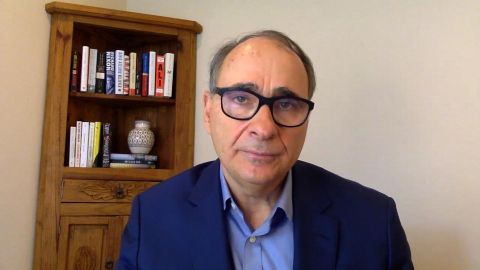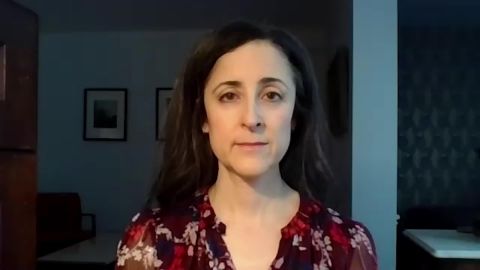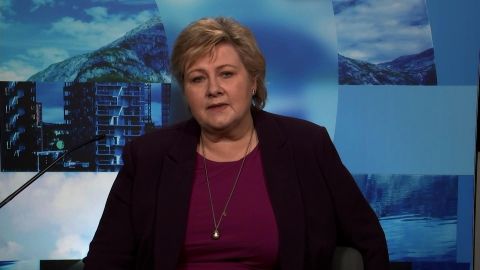Read Transcript EXPAND
CHRISTIANE AMANPOUR: Now, in this war, hospitals are the front line. And nurses, doctors, medics, all those workers are the soldiers. The Pulitzer Prize-winning journalist and doctor Sheri Fink is shining a light on the harrowing day-to-day work at the Brooklyn Hospital Center. She wrote a best selling book about Hurricane Katrina, and she’s an executive producer of the timely Netflix docuseries “Pandemic,” which was released early January and before COVID reached the West. She talks to our Hari Sreenivasan about the tough ethical questions facing doctors right now.
(BEGIN VIDEOTAPE)
HARI SREENIVASAN: Dr. Fink, for people who might not have read your recent piece in “The New York Times,” describe some of the scenes that you’re chronicling at the hospital in Brooklyn.
DR. SHERI FINK, “THE NEW YORK TIMES”: It’s really not a hospital in normal times. It feels to me more like a hospital that I would have visited during a disaster. I spent some time up in the intensive care unit. And that is — as this pandemic has gone on, as people have had that time, those unlucky people who have the more severe illness, it takes some time before that shows up. And so that — last week, when I was there, that is sort of where the crisis or the pressure point had shifted, was this intensive care unit had essentially doubled. So they had 18 patients. They were now treating twice as many. And they were not all in the ICU, because the ICU only had 18 rooms. So they had taken over other parts of the hospital. There was an area that used to be for chemotherapy infusions, if you needed to come in as an outpatient to get that treatment. That was now an ICU. And it was also not just the physical space, but also the staff. About 30 percent of the doctors, the nurses were out sick. And with all of these additional patients who had very critical care needs, they had brought in people from all over the hospital to help. There were — in the intensive care unit, there was a podiatry doctor, a doctor who specializes in treating the feet. And two of her resident physicians, they were helping out. There was a neurosurgery physician assistant. So it was not business as usual. But the team was — or the hospital was sort of trying everything, pulling out all the stops to try to serve the additional patients.
SREENIVASAN: Do the doctors that you’re profiling, working with, watching, do they have enough protective gear?
FINK: Unfortunately, they’re — they’re — no, they don’t have a lot of protective gear. They have run out of things at times. Last week, it was the plastic gowns, so they were having to use substitutes, cloth gowns that they felt weren’t perhaps as protective from splashes and whatnot, obviously, the masks that we all know have been in short supply. So they’re constantly getting — they’re getting resupplied, they’re getting donations, but they’re consuming a lot because — and I have seen it. Any time they go into a room with a patient who has COVID, there’s a need to put on this protective gear. And so they’re even trying to reuse some of that gear, which they wouldn’t be in a normal circumstance. So this is a problem. And there have been many cases of health workers getting sick themselves. Of course, that could be happening out in the community. But I think there’s a good understanding that a lot of these health workers have been infected in the health care facilities in New York.
SREENIVASAN: Given that you have reported from disaster zones before, what surprised you about what’s happening at the ICU in New York City?
FINK: I think the big difference is that, when it’s a hurricane, it’s a discrete event. And, of course, there is all of that time after where things are not normal, where it takes some time to get back to normalcy, where there can be power outages. But this is something that is expected to be so long. When I was there last week, we were not at the peak yet. And so this was an incredible effort to — what they call in hospital parlance to surge, with the knowledge that they would most likely be continuing that, expanding that, because, remember, for that small proportion of people who do get critically ill, it can take sometimes a couple of weeks of intensive care before someone can turn around. So that means, as more people are coming in, you’re going to have to keep expanding that space, expanding capacity, because you’re not getting people out as quickly as they’re coming in.
SREENIVASAN: At that point, if patients are going to have to spend so long in the ICU and perhaps on a ventilator, that’s a limited and a precious resource. How are doctors making the decision on who gets a ventilator and who does not?
FINK: Well, so far, they are able to provide that to everybody who needs it and wants that type of care. But they are having those discussions. And, of course, there has been this discussion for years, if there ever were to be a pandemic, which now we have, there was real knowledge amongst people who study this kind of thing, people in medicine, people in emergency preparedness, that we just simply don’t have that many ventilators. We don’t have that many critical care beds. Obviously, even in a bad flu season, our intensive care units can get very stressed. So there have been discussions about, what would be the right way to choose, if you had to choose? Doctors at this hospital are looking at some of the work that’s been done in terms of how you would possibly make decisions like that in the most ethical way. But, at the same time, they have worked hard to get additional ventilators. They have also been — they have a simulation lab, and they’re simulating this sort of risky, but potentially possible way to go, which would be to have one ventilator treat two patients. They’re not sure how well that will work. But they’re kind of pulling out all the stops to try to prevent having to make some really tragic choices.
SREENIVASAN: Is there a guidebook for this? I mean, how do you make a decision? Is it based on my preexisting conditions, my age? Do I get a bunch of points? I mean, how do I score when I’m in the hospital?
FINK: So there have been different groups. And by groups, I mean at hospitals, at — on a state level, and even groups that have gone out to the public to ask, how should we do this? Because, in fact, it’s not really a question of medicine only. It’s also a question of values. And I would say most of the plans that have been drawn up or guidelines — and there are many of them, there’s not just one — they would have some effort to figure out who both needs that resource and is most likely to benefit from it. So, sometimes, doctors can use a scoring system. It’s a scoring system for critical care that assesses how sick somebody is, never meant to be used to ration ventilators. But at least it’s some sort of objective criteria. But, as you said, some of these plans incorporate things that are big areas of debate, whether age should be a factor. And there are different ethical arguments on both sides of that — whether somebody’s preexisting conditions should factor into it. In other words, what is their long-term chance of surviving? Should you try to not only save the most lives, but the most years of life? And that gets a little bit tricky, because, of course, people who have chronic conditions may — that may group with certain socioeconomic statuses or racial backgrounds. And so you don’t want to be — you, the person deciding, doesn’t want to be perpetuating inequities.
SREENIVASAN: In your 2013 book, “Five Days at Memorial,” you chronicled what happened after Hurricane Katrina at Memorial Hospital. That was a harrowing experience for everyone involved. How did they decide, how did they come to those conclusions on how to ration care when they realized a helicopter could only hold so many people, and we have got a lot of patients and a lot of staff here to evacuate?
FINK: So, I think that that event was, I think, what got a lot of people in the health care world to start thinking about these issues. And there were two issues there, actually. One was, you have got a hospital surrounded by water. They knew that all power could fail at any time if the water got too high, just because of where their electrical system was. And so helicopters were coming. They could take one or two patients at a time. There were almost 300 patients. So that was that question of, who do you rescue first in a situation like that? And at that time, they hadn’t been — put thought into that. It was an ad hoc decision in the moment. They did the best they could. They sort of looked at who would be most endangered if the power failed and tried to get those patients out first. But they also made some decisions about who would go last, that, when the power failed, it became a very desperate situation, and some of the sickest patients were still in the hospital. Then there was that second ethical choice that happened, which is, what do we do if we believe that some of the patients are not going to make it? And, as people might remember, this was that famous case where, about a year after the storm, a doctor and two nurses were arrested and accused by the attorney general of second-degree murder, of intentionally hastening the deaths of their patients in that very desperate circumstance. They have always maintained their innocence, but I have interviewed some doctors who told me that they themselves had intentionally hastened the deaths of their patients. And that was a separate issue, a very — that had a lot of ethical and legal implications. And, certainly, expert groups that have looked at that situation and have said that, even in the midst of a crisis, that we don’t want to cross that line as health professionals, but, of course, very, very difficult circumstances.
SREENIVASAN: So what does the industry learn from Hurricane Katrina moving forward? How did it change? How did we better prepare?
FINK: I think that one thing can be said for sure, which is that there was more attention to this concept of preparing our nation’s health institutions for a crisis, for an emergency. And so there was more of a recognition that that was important. And, in fact, it took many years, over a decade, but the CMS, Centers for Medicare and Medicaid Services, actually had a new rule that came into effect a couple of years ago that required a level of emergency preparedness for all health care provider types who accept Medicare, who participate in that program, which is the vast majority of them. But those were really minimum standards. And, as we’re seeing now, there are big weaknesses in the preparedness of our health institutions for an emergency, whether it is the fact that they run on tight margins, they’re ordering supplies just as they need to use them, and — which, as we see, in a pandemic, when everybody else is ordering the same thing, we’re getting into these shortage situations that we’re seeing now.
SREENIVASAN: One of the narratives that comes from the White House almost daily is that no one could have seen this coming, no one could have expected such a surge in need for ventilators. And yet you’re saying that the community — the medical community has been thinking about this for quite some time.
FINK: Oh, it’s more than the medical community. I mean, this is one of the federal government’s main planning scenarios. So, our country has certain scenarios planning for rare, but potentially catastrophic and foreseeable emergencies that we may face as a country. And pandemics are right up there in the top group. The prediction for ventilator shortages has — it’s been known by everybody. In fact, the federal government issued grants to try to develop a pandemic ventilator for many years. And that — some of my colleagues wrote a story about how that plan didn’t, unfortunately, provide us enough ventilators in time. But this is a very well-known — I mean, any expert in emergency preparedness, federal, state, local hospital level, this — it’s very evident that this was planned for, this was — the things that we’re seeing now that are problems were known issues. For years, people have been talking about them. The problem is, we didn’t do enough to address them as a country.
SREENIVASAN: We have seen some of the images of the 18-wheelers, the semis that are outside, the makeshift morgues. It’s pretty shocking to see in a city like New York, with hospitals who otherwise have resources. What can you tell us about that?
FINK: So, I think that those refrigerated trailers have been distributed by the city’s office of medical — the medical examiner’s office, and it’s for a couple of reasons. One is, yes, the number of deaths are increasing. That’s more than hospitals have — are used to handling. There are more deaths. Another problem is that the funeral homes are overburdened, and they’re not picking up bodies at the same rate. We have heard some stories of — from hospitals, saying the funeral homes aren’t coming at all if it’s a COVID patient. I think that varies. And then there’s a backup at the medical examiner’s office too. They’re not able to pick up those trailers yet. They haven’t been to any great extent, is my understanding. They have asked for help from the federal government, the state government. So there’s a backup, and those trailers have to stay in front of the hospitals. And they added more trailers just to hold the bodies, until they can be dealt with at a mortuary. And so that’s in the process of being set up. And it’s been delayed. And there’s a lot of consternation about it, because, of course, when somebody dies, there is a desire to treat them with respect and for their families to have that chance to say goodbye. So this is another very difficult element right now.
SREENIVASAN: Do you think that we will ever know how many people were actually well killed by COVID-19, considering that what we’re talking about are the number of deaths through hospitals that were officially registered? But people who don’t perhaps have access or who die at home, how does that number ever get tabulated?
FINK: I feel like we don’t have a good sense of the numbers. And some of my colleagues have reported on that just in the last few days, just the problems with counting, the various ways that bodies are counted, the way that a death is attributed, the cause of death. There is some guidance now from the CDC that, if it is an emergency that that death appears to be related to, that that’s important to document that on a death certificate. But we see, for example, in New York City, where the — some of the people who are dying, very consistent stories, with likely COVID, but they haven’t had a chance to be tested, that those bodies aren’t being tested at postmortem. And that is a problem with really understanding the full scope of this pandemic. But it’s been the situation where the testing has not been available for people who are alive, people in the hospital. This hospital I have been reporting at has been waiting — until they could do their testing about a week ago, been waiting about a week to get results back from a commercial lab in California. That means it’s very hard for doctors to treat them. It’s hard to separate them within the hospital and know who’s sick, who’s not sick. This has been a — yet another impact of not having that testing capacity in this country is the problem with knowing how many people have died of COVID.
SREENIVASAN: Dr. Sheri Fink, correspondent for “The New York Times,” thanks so much for joining us.
FINK: Thank you.
About This Episode EXPAND
Christiane speaks with David Axelrod about Bernie Sanders’ decision to drop out of the presidential race. She also speaks with Norwegian Prime Minister Erna Solberg about her statement that they have the virus “under control.” Journalists Kara Swisher and Carl Cameron talk fake news and Hari Sreenivasan speaks with Dr. Sheri Fink about the ethical questions doctors are facing.
LEARN MORE



